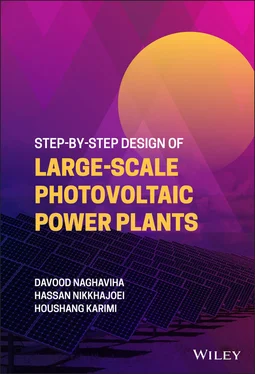Houshang Karimi - Step-by-Step Design of Large-Scale Photovoltaic Power Plants
Здесь есть возможность читать онлайн «Houshang Karimi - Step-by-Step Design of Large-Scale Photovoltaic Power Plants» — ознакомительный отрывок электронной книги совершенно бесплатно, а после прочтения отрывка купить полную версию. В некоторых случаях можно слушать аудио, скачать через торрент в формате fb2 и присутствует краткое содержание. Жанр: unrecognised, на английском языке. Описание произведения, (предисловие) а так же отзывы посетителей доступны на портале библиотеки ЛибКат.
- Название:Step-by-Step Design of Large-Scale Photovoltaic Power Plants
- Автор:
- Жанр:
- Год:неизвестен
- ISBN:нет данных
- Рейтинг книги:3 / 5. Голосов: 1
-
Избранное:Добавить в избранное
- Отзывы:
-
Ваша оценка:
- 60
- 1
- 2
- 3
- 4
- 5
Step-by-Step Design of Large-Scale Photovoltaic Power Plants: краткое содержание, описание и аннотация
Предлагаем к чтению аннотацию, описание, краткое содержание или предисловие (зависит от того, что написал сам автор книги «Step-by-Step Design of Large-Scale Photovoltaic Power Plants»). Если вы не нашли необходимую информацию о книге — напишите в комментариях, мы постараемся отыскать её.
Step-by-Step Design of Large-Scale Photovoltaic Power Plants,
Step-by-Step Design of Large-Scale Photovoltaic Power Plants
Step-by-Step Design of Large-Scale Photovoltaic Power Plants
Step-by-Step Design of Large-Scale Photovoltaic Power Plants — читать онлайн ознакомительный отрывок
Ниже представлен текст книги, разбитый по страницам. Система сохранения места последней прочитанной страницы, позволяет с удобством читать онлайн бесплатно книгу «Step-by-Step Design of Large-Scale Photovoltaic Power Plants», без необходимости каждый раз заново искать на чём Вы остановились. Поставьте закладку, и сможете в любой момент перейти на страницу, на которой закончили чтение.
Интервал:
Закладка:
Based on the IEA forecasts about the PV plant installation capacity, it can be concluded that:
For the stated policies scenario, the PV plant installation capacity grows to about 250%.
For the sustainable development scenario, the PV plant installation capacity increases to about 420%.
For the NZE2050 scenario, the PV plant installation capacity grows to about 530%.
As a result, for the worst‐case scenario, a PV plant installation capacity of 1250 GW is expected to be added to the existing capacity by 2030.
1.5 A Review on the Design of Large‐Scale PV Power Plant
For the construction of a LS‐PVPP, it is necessary to conduct preliminary studies, feasibility studies, and to obtain initial permits. Then, the most important stage is the design and engineering of PV plant. In this section, an overview of the technical literature is presented.
The relationships between solar geometry and the theory of PV cells are presented in [11]. A guide on the fundamental problems of a PV power plant is given in [12]. In [13], a method to locate a LS‐PVPP is presented. Reference [14] focuses on the control and performance of large‐scale PV plants and examines the requirements of the grid code, active and reactive power control, and the dynamics of large‐scale PV plants under various temperature and radiation conditions.
A PV handbook that deals with the details and theories of PV modules and solar inverters are given in [15]. A design and installation guide for equipment of a PV plant is proposed in [16]. A solution for reducing subscribers' bills by installing a PV plant is discussed in [17]. In [18], feasibility studies for the PV plants are presented. A method for the optimization of the design of a PV plant to maximize its energy production through the shading analysis is proposed in [19]. Reference [20] presents a method for selecting the optimal inverter and PV modules for a PV power plant. A method for determining the cable size of a PV plant is presented in [21]. In [22], few topologies for the monitoring system of a PV plant are examined. The design of distribution transformers for a PV plant based on harmonic specifications is discussed in [23]. The protection system of a PV plant is discussed in [24, 25], and the grounding system design is presented in [26].
1.6 Outline of the Book
In Chapter 2, a review of the design requirements of a LS‐PVPP is presented and various equipment of the plant is introduced. In Chapter 3, first the key points and general definitions of feasibility studies of a PV plant are introduced. Then, the criteria and requirements of a feasibility study report for a large‐scale PV plant are presented.
In Chapter 4, the network connection studies of a PV power plant are discussed and the main parts of the network connection studies and its requirements are described. The single‐line diagram of a sample PV plant is presented in detail. The PV plant is modeled in software, and load distribution analyzes, emergency situations, single‐phase and three‐phase short circuits, power quality, and stability are examined and evaluated.
In Chapter 5, first, the generalities related to solar sources, geometry, and radiation are presented. Then, a method to calculate the solar‐related parameters such as total annual radiation per surface, azimuth angle, altitude angle, tilt angle and orientation, shadow distances, and row spacing is introduced.
In Chapter 6, the design methodology and documents of a LS‐PVPP are presented. Moreover, the steps to design various equipment of a large‐scale PV plant are discussed. The steps include preparing a feasibility study report, engineering documents, basic design, tender documents, and detailed design. Finally, a flowchart for the optimal design of a PV plant is also proposed.
The design of the DC side of a large‐scale PV plant is presented in Chapter 7. The main equipment that should be determined in the DC side is introduced. The technical specifications and technologies of PV modules and solar inverters are also discussed. It is explained how to determine the PV string size, the inverter operating range, the number of inverters, the size of DC cable, and the type of fuse, surge arrester, and DC switch.
Chapter 8introduces the power losses related to a PV plant and the parameters affecting the equipment’s losses. Moreover, the performance ratio, the monthly and annual output energy productions of a PV plant are discussed.
References
1 1 Twidell, J. and Weir, T. (2015). Renewable Energy Resources. Routledge.
2 2 Dincer, I. and Abu‐Rayash, A. (2019). Energy Sustainability, 75. Academic Press.
3 3 González‐Roubaud, E., Pérez‐Osorio, D., and Prieto, C. (2017). Review of commercial thermal energy storage in concentrated solar power plants: steam vs. molten salts. Renewable and Sustainable Energy Reviews 80: 133–148.
4 4 Vázquez, N. and Vázquez, J. (2018). Photovoltaic system conversion. In: Power Electronics Handbook (ed. M.H. Rashid), 767–781. Butterworth‐Heinemann.
5 5 Kalogirou, S.A. (2013). Solar Energy Engineering: Processes and Systems. Academic Press.
6 6 Goodrich, A., James, T., and Woodhouse, M. (2012). Residential, commercial, and utility‐scale photovoltaic (PV) system prices in the United States: current drivers and cost‐reduction opportunities (No. NREL/TP‐6A20‐53347). National Renewable Energy Lab.(NREL), Golden, CO.
7 7 Jung, D., Salmon, A., and Gese, P. (2021). Agrivoltaics for farmers with shadow and electricity demand: results of a pre‐feasibility study under net billing in Central Chile. AIP Conference Proceedings (Vol. 2361, No. 1, p. 030001). AIP Publishing LLC.
8 8 Rakhshani, E., Rouzbehi, K., Sánchez, A. et al. (2019). Integration of large scale PV‐based generation into power systems: a survey. Energies 12 (8): 1425.
9 9 Feldman, D., Ramasamy, V., Fu, R. et al. (2021). US solar photovoltaic system and energy storage cost benchmark: Q1 2020 (No. NREL/TP‐6A20‐77324). National Renewable Energy Lab.(NREL), Golden, CO.
10 10 IEA. Global solar PV and coal‐fired installed capacity by scenario (2010‐2030). IEA, Paris https://www.iea.org/data‐and‐statistics/charts/global‐solar‐pv‐and‐coal‐fired‐installed‐capacity‐by‐scenario‐2010‐2030(accessed 12 October 2020)
11 11 Fahrenbruch, A. and Bube, R. (2012). Fundamentals of Solar Cells: Photovoltaic Solar Energy Conversion. Elsevier.
12 12 White, S. (2018). Solar Photovoltaic Basics: A Study Guide for the NABCEP Associate Exam. Routledge.
13 13 Saracoglu, B.O., Ohunakin, O.S., Adelekan, D.S. et al. (2018). A framework for selecting the location of very large photovoltaic solar power plants on a global/supergrid. Energy Reports 4: 586–602.
14 14 Cabrera Tobar, A.K. (2018). Large scale photovoltaic power plants: configuration, integration and control. Doctoral thesis. Electrical Engineering Department, Universitat Politecnica de `Catalunya, Barcelona‐Spain.
15 15 Markvart, T. and McEvoy, A. (eds.) (2003). Practical Handbook of Photovoltaics: Fundamentals and Applications. Elsevier.
16 16 Deutsche Gesellschaft für Sonnenenergie (DGS) (2013). Planning and Installing Photovoltaic Systems: A Guide for Installers, Architects and Engineers. Routledge.
17 17 Al‐Najideen, M.I. and Alrwashdeh, S.S. (2017). Design of a solar photovoltaic system to cover the electricity demand for the faculty of Engineering‐Mu'tah University in Jordan. Resource‐Efficient Technologies 3 (4): 440–445.
18 18 Moh'd Sami, S.A., Kaylani, H., and Abdallah, A. (2013). PV solar system feasibility study. Energy Conversion and Management 65: 777–782.
19 19 Rachchh, R., Kumar, M., and Tripathi, B. (2016). Solar photovoltaic system design optimization by shading analysis to maximize energy generation from limited urban area. Energy Conversion and Management 115: 244–252.
Читать дальшеИнтервал:
Закладка:
Похожие книги на «Step-by-Step Design of Large-Scale Photovoltaic Power Plants»
Представляем Вашему вниманию похожие книги на «Step-by-Step Design of Large-Scale Photovoltaic Power Plants» списком для выбора. Мы отобрали схожую по названию и смыслу литературу в надежде предоставить читателям больше вариантов отыскать новые, интересные, ещё непрочитанные произведения.
Обсуждение, отзывы о книге «Step-by-Step Design of Large-Scale Photovoltaic Power Plants» и просто собственные мнения читателей. Оставьте ваши комментарии, напишите, что Вы думаете о произведении, его смысле или главных героях. Укажите что конкретно понравилось, а что нет, и почему Вы так считаете.












